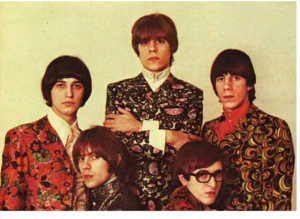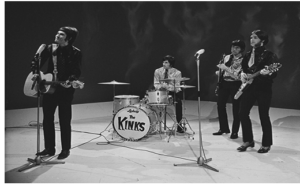Frank Vigon gave a wonderful talk that took most of us back to our youth in the sixties. Frank told us of his early childhood spent playing on bombsites in the fifties and said he was a child of the war and that the Second World War had shaped the sixties. He grew up in a world of music and violence, Teddy Boys, knuckle dusters, razors bicycle chains, spivs, the black market, San Izal toilet paper… remember that?
A national cure was applied – Conscription into the National Services for males over the age of 18.
Then came the rise of the Permissive Society, in three to five years there was a social revolution due to three main seismic reforms. Firstly the Obscene Publication Act, you may remember the furore over Lady Chatterley’s Lover. Secondly the Sex Offenders Act in 1967 legalised homosexuality, thirdly the Abortion Law Amendment Act. All these meant the people especially women who had access to the Pill for birth control could take charge of their own lives. This led to a freer and fairer society. Macmillan told us that we “had never had it so good”.
The advent of the Barclay Card led to reform of Higher Purchase schemes. There was an enormous Cultural Revolution,in the early sixties newsreaders still wore ball gowns and dinner jackets and spoke in received English. This changed after the advent of TV advertising and things like Max Factor cream puff and cleaning our teeth with pepsodent. The renegade Radio Caroline pirate ship DJ’s later became national luvvies, Tony Blackburn still seems to be going strong.
The revolution in music that came over from America led to the rise of local groups, Gerry and the Pacemaker, the Beatles not forgetting that southern group the Rolling Stones.
Over a period of two and a half to five years fashion exploded with colour due to the influences of women like Barbara Hulanki – Biba shops and Mary Quant who gave us the mini-skirt popularised by Twiggy. The Mini Car arrived on the scene. Vidal Sassoon popularised certain hairstyles for the price of £30. Remember the Beatle haircut?
People with East London accents grew popular – David Bailey, Jean Shrimpton. The sixties also changed deference and the class system.

Jean Shrimpton. Attribution: Dutch Archives.
Love and Peace, Woodstock, Mods and Rockers – they were all going to San Francisco with Flowers in their Hair. Young people wanted to challenge the establishment.
The Joy of Sex a seminal work by Alex Comfort became popular and outraged Mary Whitehouse, ironically the effect was the opposite to what she intended as pornography increased.

Courtesy of Frank Vigon.
The sixties were said to be an age of hedonism, however not everybody became hedonistic. According to Frank, the working classes – that’s us ‘oop North, missed this as we were well brought up. Behaving well was dinned into us by our parents. Conversely it was the middle classes who were to experience more of the age of hedonism.
Ken Loach’s seminal films “Cathy Come Home” and ‘Kes’ drew attention to an underclass who didn’t enjoy the sixties due to grinding poverty and homelessness. The society divide unfortunately remains with us today.

Attribution: Kinks Fan Club
Frank finished this excellent talk on a cheerful note with “Here comes the Sun, da n da da…”. A fantastic trip down memory lane. We were there and we didn’t miss ‘it’ and it’s now part of our heritage.
Did you know?
That Margaret Thatcher pioneered soft ice cream.
That it is said that Teddy Boys and their suits were the result of a man making Edwardian suits that turned out to be too small and were badly fitting. He sold them cheaply in Manchester first and the trend took off from there.
Banner Image: Carnaby Street in the Sixties. Attribution: H. Grobe